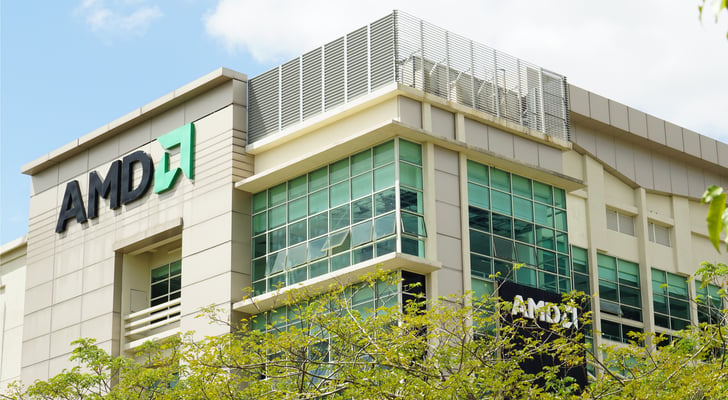For a few months, the stock of semiconductor company Advanced Micro Devices (NASDAQ:AMD) was trading on hopes and dreams of a brighter future for AMD and AMD stock. Specifically, investors fantasized about the company rapidly stealing market share from competitors and morphing into a third legitimate competitor in the CPU/GPU market alongside Nvidia (NASDAQ:NVDA) and Intel (NASDAQ:INTC).
Those hopes and dreams were shattered on Wednesday, when AMD reported third-quarter numbers that simply didn’t live up to the hype. The company’s earnings beat expectations, but its revenues missed the consensus estimate, and its fourth-quarter guidance came in below the consensus outlook. AMD stock price plunged more than 15%, after dropping sharply on Wednesday before the report was released.
It’s down even more today. Overall, AMD stock price has dropped more than 45% over the past month.
What now? AMD stock price no longer reflects baseless speculation, and the momentum of AMD stock has shifted dramatically towards the downside. That means it is time to pay closer attention to the chip maker’s fundamentals.
Those fundamentals imply that while not all hope is lost for the company, AMD stock price will struggle to advance beyond $20. Having said that, as AMD stock drops towards $17 and lower, the bull thesis does look somewhat compelling. But tech markets are a mess, so investors will need to exercise patience before rushing in to buy the dip. But I don’t think AMD will stop growing just yet, and I believe the company’s fundamentals do support some advances by AMD stock going forward.
AMD’s Quarter Was Good, But Not Good Enough
Despite the negative reaction of AMD stock to the results, AMD’s third-quarter earnings report was actually pretty good.
Its revenue growth was weak. But that was mostly due to the declines of its blockchain revenue, which essentially went from comprising a high-single digit portion of AMD’s total revenue a year ago to essentially nothing in Q3. Excluding the demise of AMD’s crypto-mining business, revenue growth remained healthy, powered by stronger demand for the company’s Ryzen and EPYC chips.
Importantly, during the quarter EPYC won major cloud contract deals with Microsoft (NASDAQ:MSFT), Dropbox (NASDAQ:
DBX), Xilinx (NASDAQ:XLNX) and Oracle (NASDAQ:ORCL), causing the chip’s market share to rise. Meanwhile, robust Ryzen adoption enabled AMD to ship the most processors in four years last quarter.
On top of all that, the continued strength of AMD’s new products drove its gross and operating margins higher. Specifically, AMD’s gross margins rose four percentage points year-over-year, while its operating margins expanded two percentage points year-over-year.
Overall, AMD’s quarter was pretty good. EPYC and Ryzen are both performing well, and the company’s profitability is steadily improving. Meanwhile, AMD’s upcoming, next-gen seven-nanometer-datacenter GPU should be a positive catalyst for AMD stock. The only really negative aspect of the report was the disappearance of the company’s blockchain revenues, but no one really expected those to continue forever.
If the quarter was good, why did AMD stock drop? Because AMD stock was overvalued and over-hyped heading into the print. The stock had gone from $10 to $35 in a hurry. AMD stock price had fallen to $23 just before the Q3 results were unveiled, but that still represented a gain of close to 100% for the year. Everyone was hoping the Q3 numbers would be shockingly tremendous.
They weren’t. They were simply good. As a result, AMD stock price fell back to Earth.
AMD Stock Looks Fairly Valued Around $20
With all the hype surrounding AMD stock gone, it is now time to focus on this company’s underlying fundamentals. Those underlying fundamentals are good and justify a $20 per share price tag. But they aren’t great, nor do they support a rebound back to $30 and higher any time soon.
Roughly speaking, the global semiconductor market has gone from $10 billion revenue per month in 1996 to $40 billion revenue per month today. That represents a trailing, 22-year compounded annual growth rate of roughly 6.5%. Secular trends in cloud migration, IoT development, AI improvements, and smartphone proliferation support healthier-than-usual adoption rates going forward for GPUs, CPUs, and all semiconductor equipment. Thus, over the next several years, I think it is reasonable to project 10% annual revenue growth for the global semiconductor market.
Given AMD’s new line of products and the successful ramp of these products, I think it’s also reasonable to assume that AMD’s market share will grow over the next several years. Thus, if the global semiconductor market grows at a 10% annual rate over the next five years, I think it’s reasonable to estimate that AMD’s annual revenue growth rate can reach 15% -20%.
During that stretch, AMD’s gross margins should continue to improve thanks to higher average sales prices, while double-digit revenue growth should drive healthy operating expense leverage. All together, then, AMD will be a company with 15%-plus revenue growth potential on top of healthy margin expansion potential over the next several years.
That combination could propel its EPS to $1.50 by fiscal 2023. After placing a forward price-earnings multiple of 20 on AMD, which is average for growth stocks, and discounting back by 10% per year, we are looking at a fiscal 2018 price target of just over $20. That is above where AMD stock trades today.
Thus, while the margin of safety isn’t great here, it is good. I’d wait a little longer for more weak hands to sell AMD. But eventually the weak hands will shake out, and AMD stock price will stabilize. When that happens, AMD stock could rally back towards $20.
Bottom Line on AMD Stock
As it has many times before, AMD went up in a hurry and came down just as quickly. I’m not convinced a rapid recovery to $30 is in the cards. But a recovery to $20 does look likely once tech markets stabilize.
As of this writing, Luke Lango was long NVDA and INTC.

